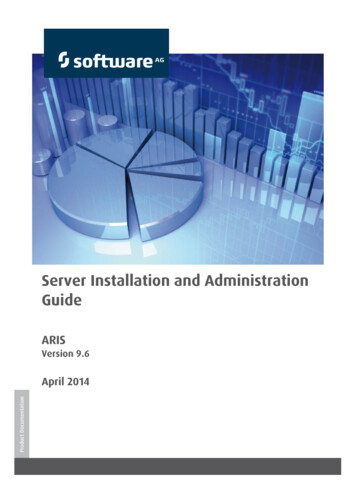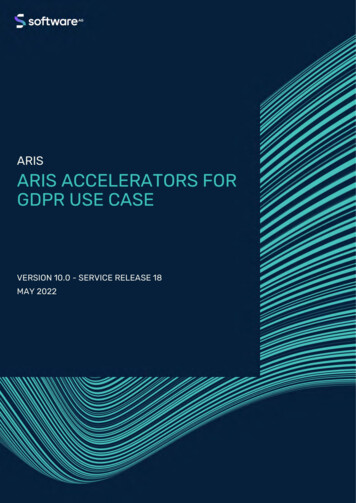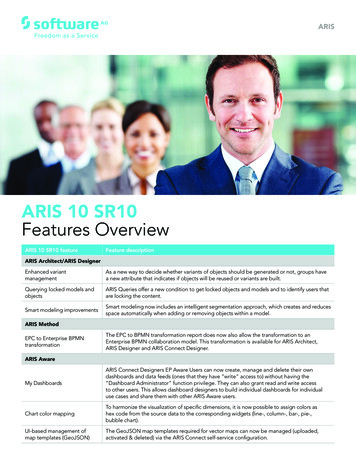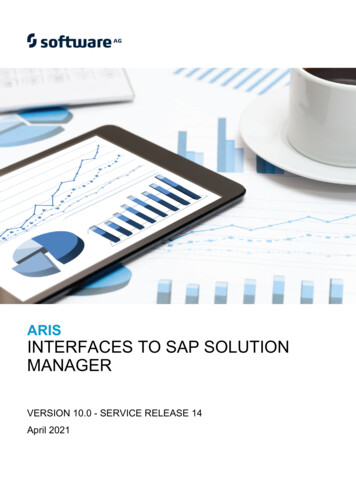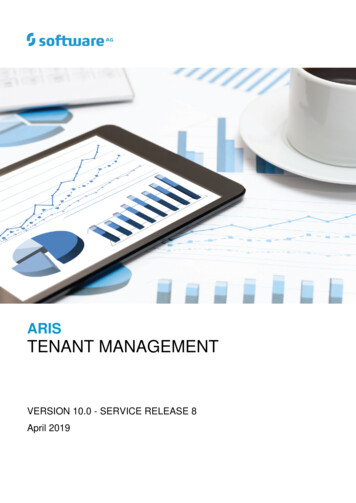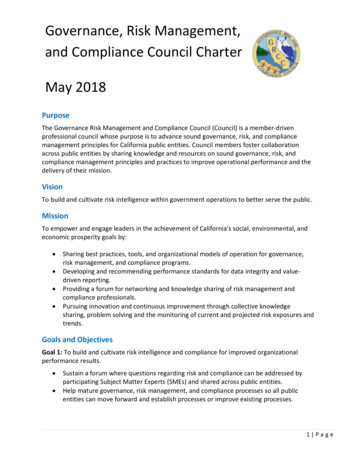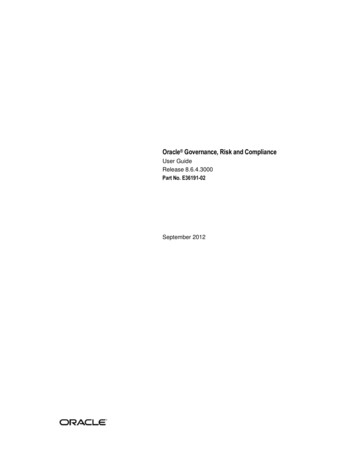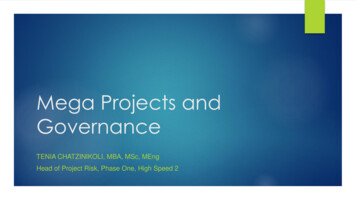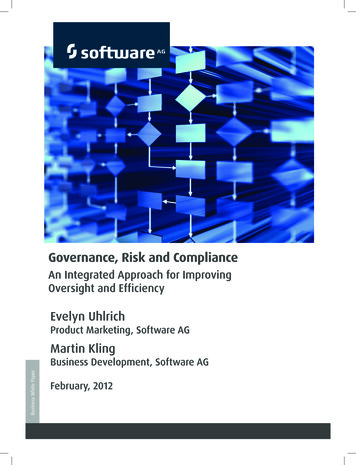
Transcription
Governance, Risk and ComplianceAn Integrated Approach for ImprovingOversight and EfficiencyEvelyn UhlrichProduct Marketing, Software AGMartin KlingBusiness White PaperBusiness Development, Software AGFebruary, 2012
CONTENTSABSTRACT3FOUR ELEMENTS OF GOVERNANCE, RISK AND COMPLIANCE4IT CHALLENGES RELATED TO THE GRC FRAMEWORK5PRIME FOR GRC: PRIMED FOR BETTER TIME-TO-VALUE7ARIS AT WORK WITH PRIME: A REAL-WORLD EXAMPLE9CALCULATING THE VALUE OF GRC11LOOKING AHEAD: WHAT’S NEXT FOR GRC12BIBLIOGRAPHY13Evelyn Uhlrich is responsiblefor global marketing ofSoftware AG’s Governance,Risk and Compliance (GRC)Solution. Evelyn graduated incomputer science from theUniversity of Applied Sciencein Darmstadt, Germany, andher postgraduate studies werein business economics at theUniversity of Applied Sciencein Berlin. She worked formultiple software vendorsbefore joining Software AG in2007.Martin Kling has overallresponsibility for Software AG’sGovernance, Risk and Compliance Solution. Besides drivingthe development of newcapabilities to help customersincrease their GRC maturity,Martin is actively involved insupervising customer projectsduring setup and delivery.Martin is also a well-knownauthor on various GRC topicsin books, articles and blogs.2W H IWT EH PAI T EP PAE R P EIRN T EGLOL VI GEERNNTA GNUC EI D, ER IFSÜKR AENNDT ECOR PMR PI SLEI ABNPCME
ABSTRACTYour company likely faces huge pressures in an increasingly complex environment that’sdominated by market globalization, shrinking development cycles and constantly changinglegal, political, cultural and technical requirements. In addition to local regulations, laws andbusiness practices of other countries and cultures also impact how your company operates.[1]Once your enterprise enters a particular market, you generally have no choice but to meet thegiven requirements.Corporate Governance, Risk and Compliance (GRC) management can help you manage thesepressures. GRC offers steering mechanisms to control the way your enterprise operates. Takingan integrated GRC approach enables you to manage risks and compliance requirements relatedto environmental practices, processes, business partners and internal policies as well as financial,operational and IT controls.An integrated approach is essential to sharing information and improving processes—thereby,increasing efficiency, improving oversight and optimizing strategic performance within a givenset of boundaries. [2]Read this white paper to find out: The elements of GRCThe value of an integrated GRC frameworkHow GRC improves efficiency and reduce costsHow to calculate the value of GRCWhy siloed GRC solutions won’t work for the long termThis white paper also explains Software AG’s proven GRC methodology called Prime. Read onto learn how ARIS tools can work with this methodology to assure compliance and deliverlong-lasting business benefits.W H I T E PA P E R GI NOTVEELRL NI GAENNCTE G, UR I DSKE FAÜNRD ECON TME RP PL IRAI NS EC EB P M3
FOUR ELEMENTS OF GOVERNANCE, RISK & COMPLIANCE1. GovernanceGovernance focuses on defining codes of conduct and processes for organizations and theirstaff to ensure compliance.[3] Corporate governance defines the boundaries in which businesswill be running. Typical measures resulting from corporate governance are guidelines or policies.A governance framework may comprise organizational measures, such as: security policies;instructions and signatory policies; and the documentation of governance processes, such asrisk assessment, the way orders are approved and requesting/approving system accessauthorization. In addition to being implemented at the organizational level, many of thesepolicies and processes are supported by IT systems.As part of corporate governance, IT governance seeks to create organizational structures andprocesses that align IT with corporate strategy and support value-adding business processes. [4]2. Risk managementAll business activity involves risk resulting from uncertainty. But only those who are preparedto actively take on risk can develop strategies for their companies that result in success. [5]Therefore, risks need to be managed.Risk management involves systematic risk identification and assessment combined with theevaluation and management of potential courses of action in response to the current situation. [6]Responsibility for enterprise risk management lies with senior executives, who are supportedby the internal audit and financial controlling functions. Business unit managers and the headof IT are responsible for risk in their respective areas.The risk management process describes the interaction between organizational units andtheir roles, thus ensuring that risk management is properly coordinated. Risk management istypically established as a continuous control loop. [7] The control loop is embedded throughoutkey company departments and corporate processes, including the value-adding businessprocesses and supporting processes, such as IT processes. [8] The risk management processcomprises risk analysis, risk assessment and risk handling.Risk are typically categorized as: [9] Market risk Credit risk Operational risk originating from Processes Human behavior Systems External events that may lead to legal risk Residual risk (strategic, reputational)Risk evaluation should also include opportunities for a company to develop and grow.Figure 1: Classification of risk4W H IWT EH PAI T EP PAE R P EIRN T EGLOL VI GEERNNTA GNUC EI D, ER IFSÜKR AENNDT ECOR PMR PI SLEI ABNPCME
3. Compliance managementThe objective of compliance management is adherence to external requirements, such as laws,and internal regulations, such as corporate policies. This includes both statutory regulations andde facto or other standards that organizations choose to apply for competitive or ethical reasonsas defined by corporate strategy.Risk management is considered as the driver of compliance management. Risks arise from noncompliance with legal requirements and de facto standards or corporate risks arising in the dailyworking routines. [10]4. Audit managementIn an integrated GRC system, effective risk management and compliancy to regulations andpolicies pave the way for successful audit management. With the climbing numbers and typesof audits and the increasing business complexity that apply to companies, the demand of anintegrated GRC system based on business processes increases.Existing silos and point solutions are of little help when addressing the needs of audit managers.The Software AG GRC Solution helps internal auditors manage papers, schedule audit-relatedtasks time management and reporting. To secure consistent information throughout theenterprise, content information relevant to GRC, such as policies, control test evidences,incident reports as well as previous audit findings, are all managed within the GRC platform.IT CHALLENGES RELATED TO THE GRC FRAMEWORKAn organization’s strategy is implemented in its value-adding business processes. These processesare supported by IT services that represent the output of IT production and management processes(derived from IT strategy) and are designed to meet business requirements. IT services for businessand IT are based on the relevant applications (see Figure 2).Figure 2: GRC related requirements to a companyW H I T E PA P E R GI NOTVEELRL NI GAENNCTE G, UR I DSKE FAÜNRD ECON TME RP PL IRAI NS EC EB P M5
A company-specific governance framework comprising governance processes, such as riskmanagement and emergency management, and associated policies and rules, such as securitypolicies, signatory policy, escalation plans and contingency plans, has been put in place tomitigate these risks.Because a large number of different stakeholders and various country-specific issues areinvolved, the governance, risk and compliance framework needs to meet a range of highlycomplex requirements [11]. Since business processes are increasingly dependent on IT systems,virtually every risk and compliance management requirement has an IT dimension.Just-in-time production in the auto industry, for example, involves a highly synchronized deliveryschedule for materials and parts, which is calculated using sophisticated Enterprise ResourcePlanning (ERP) and supply chain management systems. Clearly, these processes are highlydependent on IT.Other requirements, such as segregation of duties in accordance with the Sarbanes-Oxley Act(SOX) [12], also necessitate the implementation of identity and access management. They impactthe user application and user approval process, as well as the definition of business user rolesand IT user roles.Experience shows that efficient introduction of a GRC framework is only possible if business andIT are involved. Sponsorship at the board or senior management level serves to accelerate theprocess.Reasons to implement a GRC framework include: Legal Economic (business continuity management) Operational (IT savings realized by reorganizing in accordance with ITIL, for example)The opportunities resulting from new-found transparency between business processes andbusiness continuity management are usually overlooked. Along with benefiting from theefficiency and effectiveness provided by business continuity management, cost savings caneasily be achieved in this particular case—that is, by rightsizing Service Level Agreements(SLAs) based on the relevance of individual IT systems.6W H IWT EH PAI T EP PAE R P EIRN T EGLOL VI GEERNNTA GNUC EI D, ER IFSÜKR AENNDT ECOR PMR PI SLEI ABNPCME
PRIME FOR GRC: PRIMED FOR BETTER TIME-TO-VALUESoftware AG offers a flexible and proven methodology for GRC called Process ImprovementMethodology (Prime). Prime provides a process-driven guide to implementing a GRC platform.You can implement GRC as a standalone solution or one that’s combined with any otherSoftware AG solution. Individual methodologies from hundreds of projects can be customizedor combined to support new solutions, services and individual customizations.Prime incorporates: A framework consisting of an implementation and deployment process for the entiresolution A project lifecycle that’s composed of phases, work packages, processes and procedures An inventory of accelerators in the form of best practices, guidelines, tools and templatesto support the execution of detailed work steps and generate predefined deliverables Integration between the solution methodology and a proven project managementmethodology to ensure project success and the timely and qualitative creation of thepromised deliverables A library of content based on leading industry reference architecturesAll of these elements work together to guarantee project success with predictable delivery dates.Figure 3 shows Prime for GRC in the form of a low-granularity value chain. The strategy,design, realization, operation and control phases are described along with the core activitiesand results of each phase.Figure 3: Compliance Management RoadmapThe following text describes each phase with its working steps and goal achievements inmore detail.W H I T E PA P E R GI NOTVEELRL NI GAENNCTE G, UR I DSKE FAÜNRD ECON TME RP PL IRAI NS EC EB P M7
Phase 1: StrategyThe strategy phase involves analyzing an organization’s existing compliance and risk situation.The results of this analysis can include: An objective in the form of outcomes to be achieved by the projectA set of compliance requirements that may be relevant to the companyThe impact of compliance requirements on business, IT and governance processesA risk matrix categorizing the risks identified in a risk catalogA catalog of measures for handling riskDefining the project scope and establishing the documentation or modelling status enables abusiness case to be constructed that sets out the anticipated benefits of the project. Creatingthe project plan enables a proper project setup.Phase 2: DesignThe design phase is where the requirements from the strategy phase are mapped into the valueadding and IT processes. This may involve assigning critical tasks to multiple users (dual-controlprinciple), incorporating additional approval mechanisms or establishing risk controls. Governanceprocesses, such as compliance management and risk management, are designed and documentedin line with defined requirements. Reports are defined for the various stakeholders. Requirementsare defined for implementing software support of risk management or compliance processes—forexample, via workflow systems.The design phase results in a comprehensive business concept in documented form that can beused for system and organizational implementation. If new software is required for system support,the business concept is a valuable source of information for preparing and evaluating RFQ documents.Phase 3: RealizationIn this phase, the content from the design phase is translated into an IT concept and the selectedsoftware is installed and configured accordingly. Any in-house development work also takesplace during the realization phase. Potential users of the systems and employees impacted byorganizational changes are trained and prepared for their role in operating the GRC framework.User feedback options are created, and performance and acceptance tests are designed andimplemented. At the end of this phase, the GRC framework is up and running.Phase 4: Operation & ControlThis phase is about supporting operational use of the GRC framework. Progress toward definedobjectives is continuously measured and documented. The results are used as input for furtheroptimization, thereby enabling continuous process improvement. Action taken might includeexecuting and monitoring compliance and risk management processes.Other activities include performing audits, plus executing risk controls and monitoring theireffectiveness. Regular reports are generated for the various stakeholders and can be used asproof of compliance. The results of the controlling phase serve as input for strategic fine-tuningas part of continuous business improvement.8W H IWT EH PAI T EP PAE R P EIRN T EGLOL VI GEERNNTA GNUC EI D, ER IFSÜKR AENNDT ECOR PMR PI SLEI ABNPCME
ARIS AT WORK WITH PRIME: A REAL-WORLD EXAMPLEPrime for GRC doesn’t require any tool support. However, deploying ARIS tools with Primesignificantly boosts efficiency. Software AG consultants have enriched ARIS tools with predefinedcontent, such as reference models and best practice methods, to make projects faster toimplement and more cost effective than when starting from scratch.The intent of Software AG’s Prime for GRC is to assure all needed stakeholders within thecompany are involved in the setup of the GRC framework. Prime also leverages experiencegained from previous projects and assures all groups address risks, controls and issues thesame way.A company can use ARIS to implement operational workflows for risk management and createreports. ARIS can automate project steps, such as publishing role-based models and documentation on the corporate intranet or any content that’s essential when establishing emergencymanagement.Figure 4 illustrates how ARIS tools were used in various Prime phases in an SAS 70 [13] projectat Software AG. In its data centers, Software AG runs SAP applications, ARIS and customtailored systems for customers, many of whom need to comply with the Sarbanes-Oxley Act.A Sarbanes-Oxley audit requires inclusion of companies that operate systems for the complyingorganization. A SAS 70 certificate makes it easier to include such external companies in anaudit and, hence, was requested by Software AG customers. Software AG is certified for SAS70 report types I and II.Figure 4: SAS 70 solution from Software AGW H I T E PA P E R GI NOTVEELRL NI GAENNCTE G, UR I DSKE FAÜNRD ECON TME RP PL IRAI NS EC EB P M9
At the beginning, Software AG used the balanced scorecard method developed by Norton andKaplan to define the project strategy. Standard perspectives, including those for financial, customers,processes, and learning and growth, were used. (As a side note, other customer projects haveshown that instead of learning and growth, separate employee and infrastructure perspectivescan be useful. For example, any involvement of the works council is facilitated by adding theemployee perspective.) Additionally, ITIL [14] and COBIT [15] standards were used to define KeyPerformance Indicators (KPIs) during the strategy phase.Target diagram and KPI assignment diagrams were modelled using ARIS strategy tools. KPIassignment diagrams contained targets and KPIs for measuring target achievement along withinformation on organizational responsibility.The strategic results were used to define the organizational structure (such as organizationalcharts and role diagrams) and process organization (including process models for value chainsand event-driven process chains with differing levels of granularity).Software AG’s ITIL V3-based reference model was used as the foundation. This model contains apredefined organizational structure and process organization as well as KPIs for various processesand a data model and can be used by organizations of all sizes in a wide range of industries.Using this reference model meant there was no need to start from scratch, which saved timeand money because only the models had to be adapted to this unique situation. The Software AGspecific models are part of Software AG’s quality management system and were also usedas the basis for ISO 9000:2000 certification. In addition, the models are published on a rolespecific basis on the intranet and are accessed by users for training and task descriptionpurposes.SAP Solution Manager was chosen as the implementation platform and operational system forservice management. Customizing information and documentation were transferred automaticallyfrom ARIS design tools to SAP Solution Manager via a bidirectional interface, thus raising certainelements of customizing to the model level. Governance processes ensured consistency of thesystem and model levels.In the operation & control phase, ARIS Process Performance Manager was used to manageprocess performance—for example, throughput times and SLA compliance. Personalized reportswere created for each stakeholder. Alert and escalation management procedures were alsoestablished.ARIS Risk & Compliance Manager was deployed to implement risk management and auditmanagement and to provide proof of the effectiveness of risk controls.Because strategy, design, realization and operation and control activities share the same repository,a wealth of transparent, consistent information is available for process improvement purposes.This also applies to the internal control system and quality management system. Significantsavings in process costs and resource requirements for operational processes and GRC processeswere achieved in the first year. Many Software AG customers who have implemented comparablesolutions have experienced similar results.[16]10W H IWT EH PAI T EP PAE R P EIRN T EGLOL VI GEERNNTA GNUC EI D, ER IFSÜKR AENNDT ECOR PMR PI SLEI ABNPCME
CALCULATING THE VALUE OF GRCThe ultimate goal for companies doing GRC is to become a high-performing, well-governed andwell-controlled organization. This chart explains the key benefits you can expect from GRC andhow to calculate their value. [17]KEY BENEFITBUSINESS IMPACTHOW TO CALCULATE THE VALUEHigher Business Efficiency & CostSavings Policy and control management:faster development, review, update,approval, distribution, access andattestation Reduced costs of temporary staff likeauditors; less alignment needed Risk management: faster riskidentification, analysis, evaluationand monitoring Hours saved per function multipliedby the average rate for fully burdenedrisk, compliance or audit professionals Audit management: improvedscoping, scheduling, data collectionand reporting Compliance management: easiercontrol assessments, aggregation ofdate and reporting Action management and escalation:faster event identification, notification, escalation, remediation, reviewand approval Process improvement: every GRCproject optimizes business processesRisk Reduction & TransparentCompliance Status Unified repository across different riskand compliance areas Reduced incident response costs Common approach for risk assessmentand control testing Reduced capital risks Transparent ownership of risk andcontrols Delivery of “in control” statementIncreased Business Agility Risk and controls are linked toprocesses Hierarchy of risk and controls createsrelations Transparency, hierarchy and relationsare required for business intelligence Fact-based decisions related todevelopment, procurement andinvestments Reduced fines and penalties Increase in risk exposure mitigatedper euro/hour spend Increased customer trust (intangible) Numbers of hours/days of reducedcompliance training and ramp–uptime multiplied by productive outputof new employees, partner or acquiredentity Decreased missed opportunitiesbecause of lack of compliance or riskinsights Smoother integration of businesspartners, acquired entities and newemployeesHigher Business Effectiveness Merger of overlapping laws andregulations into a common set ofbusiness requirements Re-use of business processes,compliance requirements and reportsthrough one single platform Payroll savings from avoidance ordelay of staff increases Reduced external audit and riskassessment costs Faster adaption to new regulationsW H I T E PA P E R GI NOTVEELRL NI GAENNCTE G, UR I DSKE FAÜNRD ECON TME RP PL IRAI NS EC EB P M11
LOOKING AHEAD: WHAT’S NEXT FOR GRCScrutiny of the banking industry has increased the awareness of the importance of a sustainableGRC system. Before that, GRC projects were driven primarily by external regulations or compliancerequirements, focused on providing evidence of compliance. The business case was either tocomply at any cost or face the negative impact and costs of non-compliancy.Although an increasing number of software vendors are entering the GRC market, closerinspection reveals that few of them cover the full range of GRC activities. Such solutions arebest suited to remove or relieve an existing pain point in the enterprise. Unfortunately, theseGRC approaches are siloed, which means that compliance is the only business benefit.If a second “silo” is adopted, it soon becomes apparent that sharing the same data requires amore sophisticated concept and implementation of the associated interfaces. The majority ofsolutions are not end-to-end in terms of strategy, design, realization, and operation and control.Without an integrated repository, it is hard to implement a consistent KPI system across all levelsor to incorporate a solution into the internal control system or quality management system.To properly execute a sustainable GRC framework, your company needs to combine best practices,skills, methodologies and technologies to create a seamless body of risks, controls and issuesthroughout the organization and its business processes. Software AG offers that in a GRC solutionthat combines the benefits of Prime and also ARIS tools as your needs require.ARIS, for example, offers a governance engine that can create a workflow instance and executeit using the information stored in the repository.In the future, more companies will look for operational support of governance processes basedon governance rules and using data held in a shared repository—ultimately moving to real-timemonitoring and GRC management. This will allow managers to bring regulatory intelligence intoGRC dashboards accessible via mobile devices or via online cloud–based services.For more information on the Software AG GRC Solution, visit www.softwareag.com.For more details on how Software AG can help with your specific GRC requirements, contactyour local Software AG representative.12W H IWT EH PAI T EP PAE R P EIRN T EGLOL VI GEERNNTA GNUC EI D, ER IFSÜKR AENNDT ECOR PMR PI SLEI ABNPCME
BIBLIOGRAPHY[1] C f. Tarantino, A. (editor): Governance, Risk, and Compliance Handbook: Technology,Finance, Environmental, and International Guidance: Best Practices. Hoboken, New Jersey2008, p. 781 ff.[2] Forrester Research 2010: Market Overview: GRC Platforms, For Security & Risk Professionals,Chris McClean[3] C f. Schewe, G.: Corporate Governance – Reconciling Management, Control, andRepresentation of Interests. Berlin 2005[4] C f. Marx Gómez, J., Junker, H., Odebrecht, S.: IT Controlling – Strategies, Tools, Practice,Berlin 2009[5] C f. Keitsch, D.: Risk Management, Second Edition, Schäffer-Poeschel, 2004[6] C f. http://de.wikipedia.org/wiki/Risikomanagement, December 22, 2008[7] C f. http://de.wikipedia.org/wiki/Demingkreis, December 22, 2008[8] C f. Königs, Hans-Peter: System-Supported IT Risk Management, Second Edition, Wiesbaden,2006, p. 2 ff., p. 28 ff.[9] C f. Keitsch, D.: Risk Management, Second Edition, Schäffer-Poeschel, 2004[10] C f. BITKOM (publisher): IT Risk and Opportunity Management in the Enterprise, Berlin2005, p. 6[11] C f. BITKOM (publisher): IT Risk and Opportunity Management in the Enterprise, Berlin2005, p. 4[12] C f. Hagerty, John: ProcessWorld presentation, Berlin 2008[13] C f. http://www.sas70.com/, January 12, 2009[14] C f. http://www.ogc.gov.uk/guidance itil.asp vom, January 12, 2009[15] C f. http://www.isaca.org/Template.cfm?Section CO BIT6&Template /TaggedPage/TaggedPageDisplay.cfm&TPLID 55&ContentID 7981, January 12, 2009[16] C f. Wood, D., Business Continuity Management – Keeping the Wheels Turning. In: Opriskand Compliance 8, 2008 8, p. 18 ff.[17] ”How To Measure The ROI Of A GRC Platform for Security & Risk Professionals”by Chris McCleanW H I T E PA P E R GI NOTVEELRL NI GAENNCTE G, UR I DSKE FAÜNRD ECON TME RP PL IRAI NS EC EB P M13
TO FIND THE SOFTWARE AG OFFICE NEAREST YOU,P L E A S E V I S I T W W W. S O F T WA R E AG . COMTake the next step to get there – faster.ABOUT SOFTWARE AGWe offer our customers end-to-end Business ProcessManagement (BPM) solutions delivering low TotalCost-of-Ownership and high ease of use. Our industryleading brands, ARIS, webMethods, Adabas, Natural,CentraSite, Terracotta and IDS Scheer Consulting,represent a unique portfolio encompassing: processstrategy, design, integration and control; SOA-basedintegration and data management; process-drivenSAP implementation; and strategic process consultingand services.Software AG – Get There Faster 2012 Software AG. All rights reserved. Software AG and all Software AGproducts are either trademarks or registered trademarks of Software AG.Other product and company names mentioned herein may be the trademarks of their respective owners.SAG GRC Audit Management WP Feb12Software AG is the global leader in Business ProcessExcellence. Our 40 years of innovation include theinvention of the first high-performance transactionaldatabase, Adabas; the first business process analysisplatform, ARIS; and the first B2B server and SOAbased integration platform, webMethods.
FOUR ELEMENTS OF GOVERNANCE, RISK & COMPLIANCE 1. Governance Governance focuses on defining codes of conduct and processes for organizations and their staff to ensure compliance.[3] Corporate governance defines the boundaries in which business will be running. Typical measures resulting from corporate governance are guidelines or policies.
